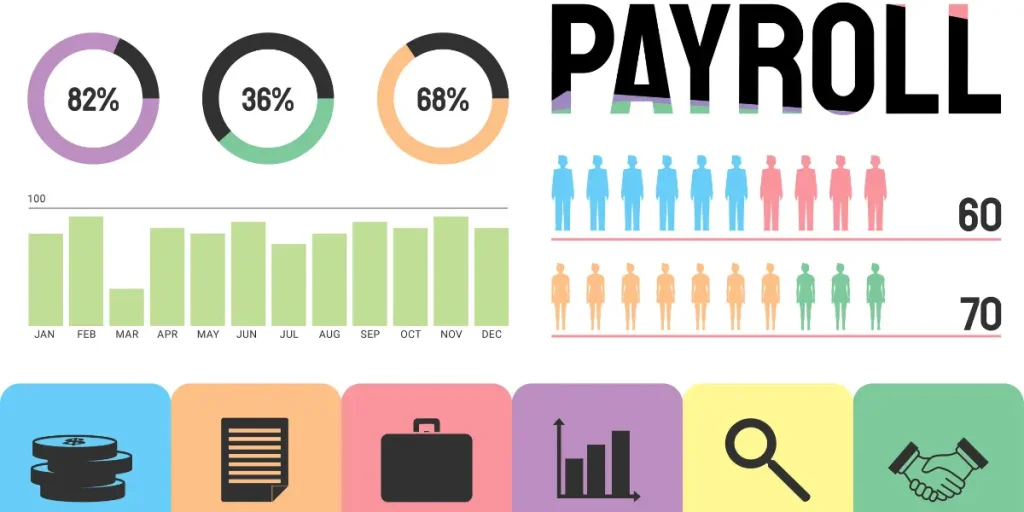The Ultimate Guide to Choosing Payroll Software: Features, Benefits, and Recommendations
Managing payroll is one of the most time-consuming and error-prone tasks for businesses. As your workforce grows, handling salaries, taxes, and benefits manually can quickly become overwhelming. This is where payroll software comes into play. It simplifies and automates payroll processes, allowing businesses to stay compliant, minimize errors, and free up time for more strategic tasks.
But with so many solutions available today, how do you choose the best one for your business? Let’s dive into what payroll software is, its key features, and how you can select the right one.

What is Payroll Software?
software is a digital tool designed to streamline payroll processes by automating tasks like calculating salaries, deducting taxes, and managing benefits. It can manage employee compensation, tax filing, and compliance tasks, reducing the chances of manual errors and ensuring businesses meet payroll regulations on time.
In essence, payroll software ensures that employees get paid accurately and on schedule while maintaining legal compliance and generating reports to assist with financial planning.
Key Features of Payroll Software
Before you settle on any software, it’s crucial to understand its core features. The best payroll solutions offer:
- Tax Calculation and Filing – Automatically calculates federal, state, and local taxes and generates the necessary filings to keep your business compliant.
- Employee Self-Service Portals – Allows employees to access their pay stubs, update personal information, and track paid time off (PTO) online.
- Compliance Management – Ensures your business stays compliant with labor laws, tax regulations, and other payroll-related rules.
- Direct Deposit and Payment Processing – Automates payment distribution, whether by check, direct deposit, or other methods.
- Time and Attendance Tracking – Integrates with time clocks and attendance systems to ensure accurate tracking of working hours.
- Reporting and Analytics Tools – Provides detailed insights into payroll data, helping you monitor expenses and make informed financial decisions.
Benefits of Using Payroll Software
- Time Efficiency and Automation: Payroll software eliminates the need for manual calculations, significantly reducing the time spent on payroll processing.
- Accuracy: Automation reduces human error, ensuring employees receive the correct pay, and taxes are calculated precisely.
- Improved Compliance: The software is regularly updated to reflect changing labor laws and tax regulations, helping businesses avoid fines and penalties.
- Cost Reduction: By automating payroll, businesses can reduce administrative costs associated with manual payroll management.
- Employee Satisfaction: With access to accurate paychecks and self-service tools, employees have more control over their financial records, boosting overall satisfaction.
Types of Payroll Software
Payroll software comes in various forms, each offering unique features and setups:
- Cloud-Based Payroll: This software operates via the Internet, allowing you to manage payroll from anywhere. It often comes with automatic updates and improved scalability.
- On-Premise Software: Installed on your company’s local servers, this option may offer more control but requires in-house IT management.
- Hybrid Solutions: Combines both cloud and on-premise functionalities, giving businesses the flexibility to choose features that best suit their needs.
Cloud-Based vs. On-Premise Payroll
Understanding the differences between cloud-based and on-premise payroll software is crucial:
- Cloud-Based: Accessible from any location with internet access, easy to scale, and typically more cost-effective. However, it relies on a strong internet connection and raises security concerns for some businesses.
- On-Premise: Offers more control over data but is often more expensive to maintain and requires IT support for updates and security.
How Payroll Software Improves Compliance
Payroll compliance involves adhering to tax laws, labor regulations, and employee benefits. Payroll software helps by:
- Managing Tax Regulations: Automatically calculating and filing taxes according to local and federal rules.
- Handling Labor Laws: Staying up-to-date with changing laws regarding wages, overtime, and employee classifications, reducing the risk of costly fines.
Choosing the Right Payroll Software for Your Business
To make the best choice, you’ll need to:
- Assess Your Needs: Identify the specific features your business requires, such as time tracking, benefits management, or compliance support.
- Consider Integrations: Ensure the software integrates seamlessly with other tools you use, like accounting or HR systems.
- Check Scalability: Look for software that can grow with your business, especially if you plan to expand.

Top Payroll Software Providers
Here are some of the most popular software options available:
- ADP: A robust solution with features for businesses of all sizes, offering payroll, benefits management, and compliance support.
- Gusto: Known for its user-friendly interface and affordable pricing, Gusto is perfect for small to medium-sized businesses.
- QuickBooks: Integrated with QuickBooks accounting software, it’s ideal for businesses already using QuickBooks for bookkeeping.
Payroll Software and Employee Benefits Management
Many payroll solutions also support employee benefits management, simplifying the administration of benefits like health insurance, retirement plans, and paid time off. This integration makes it easier for employers to provide and track employee benefits without relying on separate systems.
The Role of Payroll in Financial Planning
Payroll data can play a significant role in financial planning by:
- Helping businesses manage cash flow through accurate tracking of salary expenses.
- I am using payroll reports to make strategic decisions regarding budgeting and forecasting.
Implementing Payroll Software
To ensure a smooth implementation:
- Set Clear Goals: Know what you want the software to accomplish.
- Provide Training: Ensure your payroll team understands how to use the new software effectively.
- Use Support Services: Most providers offer onboarding support, tutorials, and customer service to assist with the transition.
The Future of Payroll
As technology evolves, software is also advancing. Key trends include:
- AI and Machine Learning: Automating more complex payroll tasks and providing smarter insights.
- Blockchain Technology: Enhancing payroll security and transparency.
- Mobile Payroll Solutions: Offering flexibility by allowing businesses to manage payroll on the go.
Conclusion
In today’s fast-paced business world, choosing the right software can drastically improve the efficiency and accuracy of your payroll operations. With features like tax management, compliance, and direct deposit, software is essential for any business looking to streamline operations and stay compliant with ever-changing regulations. By assessing your company’s specific needs, you can find the right solution that grows with your business.
FAQs
- What is the average cost of payroll software?
- Payroll can range from $20 to $200 per month, depending on the features and number of employees.
- Can payroll integrate with accounting systems?
- Yes, most software integrates with popular accounting tools like QuickBooks or Xero.
- How secure is cloud-based software?
- Cloud-based systems use encryption and secure data centers to protect sensitive information.
- How long does it take to implement software?
- Implementation can take anywhere from a few days to several weeks, depending on the software complexity and company size.
- What features should I prioritize in software for a small business?
- For small businesses, focus on affordability, ease of use, tax compliance, and direct deposit features.
